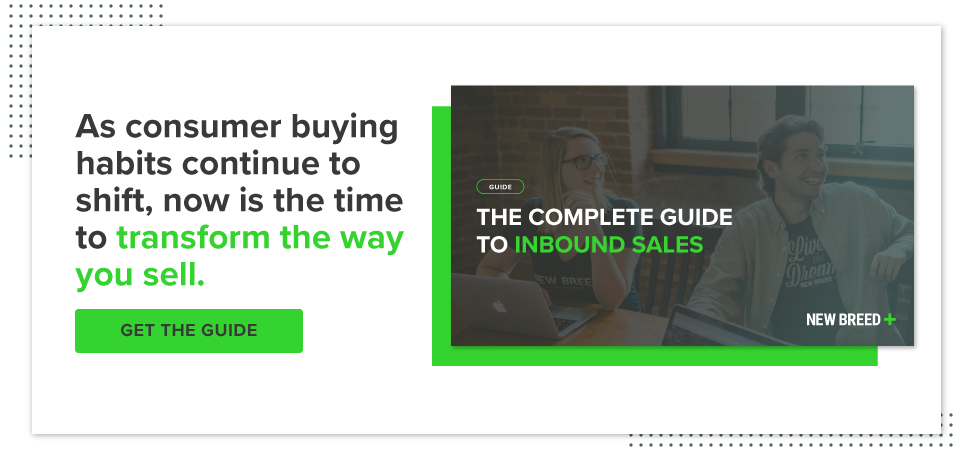Sales is often associated with the traveling salesman who goes door to door selling their products, and some companies continue to leverage outside sales to grow. But, with all of the technology available to us today, there are better ways to sell.
Relying on outside sales alone isn’t a sustainable business model. Inside sales reps can work more deals in less time than outside sales and be more effective in how they spend their days, making it a better way of operating for companies.
But transitioning how your sales team operates will be a major adjustment for your reps. The last thing you want is to have reps overwhelmed or worse, have them sitting around not sure what to do next.
What’s the Difference Between Outside and Inside Sales?
Outside sales, sometimes called field sales, is typically territory based. The sales team is organized based on geographical areas, and each rep is responsible for identifying good-fit prospects and stimulating interest in them within their assigned territories. Outside sales requires a lot of face-to-face meetings and travel time.
Inside sales is conducted from an office and is structured differently depending on the company's sales process. The reps can be grouped based on whether they work inbound or outbound leads, the types of customers they sell to, the product line they focus on or by region or country.
Some companies also have a hybrid sales team, where they organize their reps based on the territories the outside reps cover, and then inside reps will be assigned corresponding territories to support with. In that case, the inside reps might focus on the smaller deals or harder-to-travel-to prospects so the outside rep is best investing their time.
Transitioning from Outside to Inside Sales
Inside sales spend a lot more time actually working leads than outside sales because the reps don’t have to physically travel from prospect to prospect. You eliminate the commuting time from the sales process.
Outside reps are already making phone calls, checking their emails and scheduling meetings with prospects just like inside reps do. Once you move them inside, they’ll continue their same sales motions and need to replace in-person meetings with virtual meetings and cold office visits with cold calls and emails.
Despite the similarities in the work being done, moving from outside to inside sales is still a big change, and you’ll need to support your reps throughout it. You’ll need to provide some structure to guide their new work process, but avoid micromanaging.
Technology
Because of the constant travel, many outside sales reps are using sales tools that are designed for mobile devices or taking notes by hand to later transfer into a digital database.
Once they become inside reps, some of the tools they were using to track travel time and expenses can be eliminated, and you can also adopt sales acceleration and enablement tools like the HubSpot Sales Hub that will help them become more productive.
In order to effectively measure inside sales, there’s a lot of tracking that needs to be done around what sales activities they’re completing. It can be hard for a seasoned salesperson to change their way of communicating to include steps like email tracking and call logging. So, if you give them tools that truly provide value to them and will automate their processes, you can make their transition more seamless.
Office space
Going from constantly traveling to sitting at a desk for eight hours or more a day can be difficult, so make sure you’re helping your reps establish office set-ups that enable them to work effectively.
You should also foster an environment that encourages reps to be active and have the freedom to work away from their desks so the time they do spend there can be as productive as possible.
Prospect relationship building
The steps of the sales process don’t change from outside to inside sales, but the venue those activities occur at do. Reps will still be meeting with prospects but not at a restaurant for lunch or in-person at the prospect’s office.
Those face-to-face meetings were a big part of forging relationships with prospects, which made them more inclined to buy from your company. Relationships are built over the dinner table, not the conference table. Sharing a meal, having a couple drinks and talking about non-work related topics enables outside sales reps to connect with prospects — and that experience can’t be easily replicated virtually so reps have to find a new way to connect.
The best they can do is take an “always be helping” mentality and prioritize providing value for prospects. Reps might need new training or tools to do so, but they need to take extra efforts to get close to prospects through virtual means since they can’t use in-person activities to do so.
The Takeaway
Moving from outside to inside sales will be better for your company’s continued success, but it is a shift for your sales team. It’s important to support them throughout the transition and invest resources in training and tools that can make the change easier.
It might also be a good opportunity to consider shifting your sales methodology from outbound to inbound. The hardest part of losing in-person interactions is finding a different way to build relationships. Inbound is based on building trust with prospects so that they find you on their own terms, which fosters better relationships with both your brand and your reps from the start.
Heather Chevalley
Heather manages new revenue and partnerships at New Breed. With over 12 years of B2B sales experience and more than 8 years working with B2B SaaS companies, she is an expert communicator and excels at managing enterprise-level relationships.





